Written by: Melody Davis, Master Gardener apprentice
Many years ago, our family returned from a two-week vacation visiting family back East. We were looking forward to getting back to our newly built home in Pueblo West and filled with visions for all we wanted to do with our property.
We pulled into the driveway (or attempted to) in complete dismay. There had been some heavy rain in our absence and every inch of disturbed soil was covered in a thicket of tumbleweed that stood above our knees! I had never seen weeds grow so quickly. A kind friend who was a farmer came and helped us get the weeds under control, but our vision for landscaping was undergoing a rapid revision!
With an acre of wild prairie to tame, annuals that must be replanted every year were simply not practical as a foundation for our landscaping, so I began my perennial wish list. Then when we began getting our water bills, I realized that my yard was not going to be able to look like those lush gardens in magazines even if those plants could survive in our 5b-6a zone! To my great delight though, I have found that there is such a beautiful array of Waterwise perennials in all shapes, sizes, and colors that my “wish list” is quite long and I add to it all the time.
Before we delve into specific plants, I want to mention just a few things I’ve found to be helpful over the years as I’ve adapted to gardening in our region.
- With a shorter growing season, I lean towards plants that burst forth with color quickly in the spring and continue to bloom into the fall for my foundational perennials.
- I also like to plant things that develop a large canopy because weeds seldom grow underneath that canopy thus helping me with weed control; smaller plants planted in groupings can also achieve the same effect.
- Pay attention to those plant tags. Look at the zone, light and water requirements, height and width. I’ve learned the hard way that these are really important. I like to keep one tag for each type of plant, write the year on it, and throw them in a file folder. I reference that folder quite often.
- As you drive around town, take note of the landscaping. What you see a lot of should grow well for you too. A rare plant here and there might be the result of a unique microclimate, a lot of tender loving care, or even a new planting that hasn’t been tested by a Pueblo winter, so do a bit of research.
- Local nurseries, as opposed to big box stores, are a great source for both plants and information specific to our region.
There are so many plants that are perennial, bringing pleasure year after year. There are large shrubs like Rose of Sharon, Cisterna Plum, Snowball bush, and Elderberry that thrive here. Perennial vines ranging from the faithful Trumpet vine to the spectacular Clematis to the delicate looking Silver Lace grace fences and arbors. A huge variety of grasses both large and small and in an array of colors and growth habits return every year and only require an annual shearing. And then there are bulbs and tubers like daffodil, iris, allium, and lilly that give such beautiful colors and ask so little in return. What I want to focus on in this article are some of the basic rewarding perennials that thrive in Pueblo with minimal water and minimal tending, and will fit nicely in your flower bed. If I miss your favorite, I’m sorry!
Potentilla fruticose (Shrubby Cinquefoil)
This is a Colorado native that blooms early and long. You can get larger and smaller varieties and they now come in many colors. Once established they are fairly drought resistant and they require very little pruning.
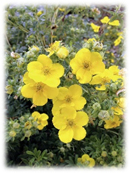
Sedum spectabile (Autumn Joy sedum)
Appropriately named, it’s a joy to watch the change in this variety of sedum through the season and beyond. It has lovely big succulent leaves that start emerging in early spring followed by flower spikes that start out green, then open in summer to reveal a mass of bright pink flowers that the bees love. The flowers fade in fall and dry into a deep maroon color. The dry stalks can stay through the winter months and make lovely additions to dried arrangements. If the stalks actually survive the winter standing erect, I love to let the new stalks shoot up and bloom along with the dried ones. These are exceptionally water wise plants.
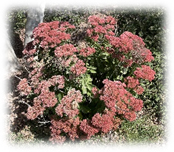
Nepeta (Catmint)
Catmint has a beautiful rounded shape and blooms for you twice! It’s just lovely all by itself and asks for very little water in exchange for its beautiful purple color.
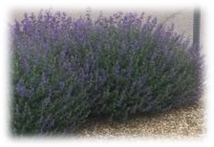
Caryopteris clandonensis (Blue mist spirea or bluebeard)
This is a beautiful, well behaved, drought tolerant plant that bears clusters of purple flowers on a well rounded bush with long stems. While it doesn’t have as long a bloom time as other similarly colored perennials, the fact that it stays exactly where you plant it and requires almost no care earns it a spot in my garden.
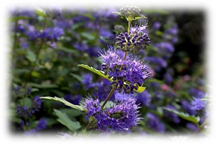
Perovskia atriplicifolia (Russian sage)
Russian sage is particularly beautiful planted in groups or three or more giving it a nice filled out appearance and grows 3-4’ high. Pros: it is extremely xeric, the color is both beautiful and long lasting once it blooms in mid summer, it chokes out weeds and the bees adore it. Cons: It is a willful plant and has no intention of staying where you plant it. It will send out unbelievably long runners so I don’t suggest planting it in a flower bed as I did. Or really anyplace where those little shoots will look unsightly until you have time to deal with them. And please wear gloves if you are weeding out the shoots! The smell sticks around for a long time.
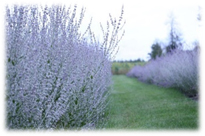
Physocarpus opulifolius(Common Ninebark)
Another Colorado native, the Ninebark is grown more for it’s foliage, which is extraordinary, than it’s flowers. Many varieties are now available in a range of sizes and colors ranging from a deep burgundy to bright green. They can grow up to 10’ tall, but with pruning they can provide a nice backdrop of color for other perennials in a flower bed. When mature, they are drought resistant.
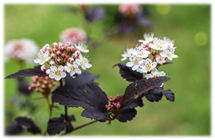
Hosta
There are many species of hostas. These are perfect for adding some color in shaded areas. I love the vibrant green color of the “Guacamole” variety. It creates a large canopy, handles our soil well, is fairly drought tolerant, and sends up tall flower spikes that pollinators love. It’s one drawback from my standpoint? If it hails, it looks pelted for the rest of the season.
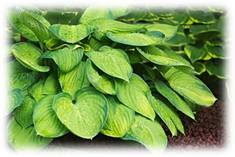
Callirhoe (Poppy Mallow, Winecups)
This is another incredibly beautiful Colorado native. This low-growing plant spreads so far that it can function as a ground cover. It has masses of hot pink flowers, is extremely xeric, and attracts pollinators. Just give it plenty of room to spread (a good 3’)or it will simply climb on top of your other plants!
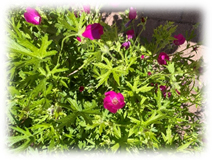
Stachys byzantine (Lamb’s ear)
I absolutely love Lamb’s ear! Its leaves are so soft and fuzzy, and its color is a lovely blue green. This plant handles poor soil, next to no water, the hot sun, and sends up tall spikes covered with small purple flowers. It makes no demands. In the spring you simply pull away the dead material to find lovely green fuzzy leaves emerging. When it sends out a new shoot, it is easily plucked out and either discarded, or just dig a hole, stick it in the soil and it will grow you a new plant.
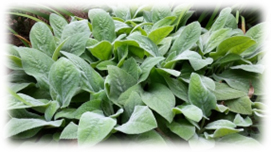
Aquilegia Caerulea James (Colorado Columbine)
We sure couldn’t leave out our exquisite state flower! It is perennial, prefers some dappled shade in our area, and attracts pollinators. There are many colors of Columbines available to create whatever palette of color you desire.
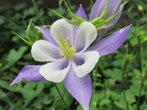
I don’t want to leave out roses, because they really do well in our climate. I lean toward the Knockout Roses because they are so independent. They don’t insist on being deadheaded, they can simply be shaped on occasion, they don’t demand to be fertilized, and they produce beautiful blooms all season long. They make a great foundational plant for the garden.
Gardening here on the prairie requires you to be more selective, but there are still so many beautiful water-wise plants that can be grown with a minimum of care and very little water. There’s no need to resign yourself to a yard covered with rock. With a little research and a good spade, you’ll be well on your way to creating a beautiful outdoor space that you’ll enjoy for years to come.


